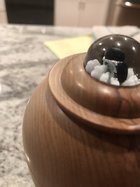I have found that to get a good oil finish, I need to sand finer than 400. Problem I’m having is I’m getting micro tear out that I can’t see until I get to 800 or 1200. Then I need to go back to coarser grits. With a film finish it would disappear, but oil is less forgiving.
Any way to make this fine tear out more visible at 220 or 320?
Here is an example on the rim of this box lid.
Any way to make this fine tear out more visible at 220 or 320?
Here is an example on the rim of this box lid.

